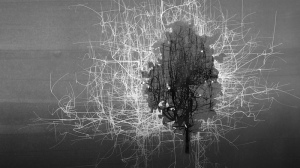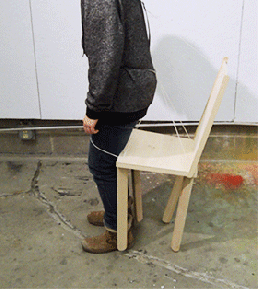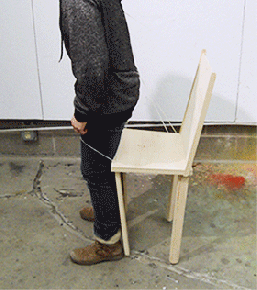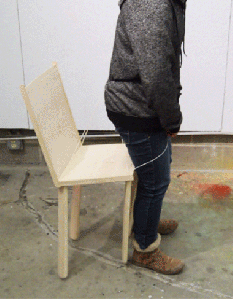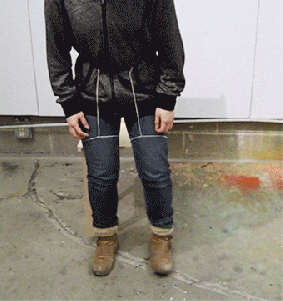Experiments in the engagement of light through the use of photography and video.
Month: February 2015
Final Reflection: Yidan
I began with a very strong desire to express the mythical sense of connectedness, that there is a fluidity between the environment and those residing within it. Thus, much of my readings were a way of distilling and creating a basis for what I had felt. Throughout this entire process, I’ve been floating in a sea of intertwining themes of cycles, awakening, and connection.
One of the earliest readings I chanced upon was a thesis by a Textiles student by Amie Young Cheong, Redefining Space Through Light, Shadow, and Memory. In her thesis, Cheong explains that wabi-sabi, the notion of keeping only the poetry of something, is left intentionally undefined, for it is “something that you feel rather than understand” (Cheong 5). This attempt at grasping wabi-sabi became a subconscious mantra in my search for the poetry of light. However, the display of Steven Holl’s watercolor paintings used to visualize space, all while also expressing the atmosphere it contains, struck me in its power of emotion. This inclusion of not just what is seen, but also felt, reveals his sensitive attention to space, getting closer to the question of why in making. More and more throughout this GISP, I have come to realize that it is not what I like that defines me, it is the why. In thinking about Computer Science and Glass, I realized that I can’t just take a system from Computer Science and implement it in Glass to create the “third thing”; there is a grander concept to be explored, the thread of interest evident in my attraction to them that forms the bridge. This pointing to of the unseen subject is very much like myths, how they are contain “signifiers that point to that-which-is-to-be-signified” (Austin 13). I realize that it is only through the pursuit of my interests can I begin to understand the reason why I like them.
While my research of myths was not as in depth as I had wanted, there were discoveries that captured snapshots of my exploration’s impetus. In The Power of Myth by Joseph Campbell, mythology was described as “‘the song of the universe’. . . music we dance to even when we cannot name the tune” (Moyers xiv). When I first read that line, I felt it bodily. There has always been something that I find myself listening for, something that I remember knowing in dreams and stories but forget upon waking. There is a space, a state that my body knows but my mind does not. In both my myth readings and group readings, I am also suddenly inundated by the unknown, the inexplicable (of course, they have always been there, but I just never accepted their presence). Especially in Meaning and Being in Myth, it was said, “In dreams and myths, they all lead to the subject, yet the subject is nowhere to be seen” (Austin 19). The lack of presence of the subject, in a sense, creates a collection of meanings, a place, rather than a concrete, definitive point. In myths, the use of certain animals or actions act as symbols, symbols that translated the subconscious interpretation of the myth creator’s world. I can’t help but see semblances of this in Computer Science, with its creation of syntax for the representation of ideas and structures. This inception of underlying relationships, like myths, might stem from observations of real-life systems, but it is also grounded in some form of intuition and interpretation.
As for my dance with light, I was taken by a quote said by Filippo Cannata in Light and Emotions: “The light seems to allude to an underground presence, another possible world that manifests itself fracturing the soil.” Such an active description of light, one that is forcibly pushing through, spilling outwards from its encasement, captured my imagination. Before, I had felt that light had a power, a presence in its existence, but this quote solidified the image of light that has broken free from somewhere else. Light is active; it bursts, floods, flashes, and washes. Yet it is something that fills up space but doesn’t take up any. This exploration feels like I’ve only just grazed the surface, but I am excited for what I will find in the future.
As for the effectiveness and replicability of this course, I see the sense of community as a vital component. I feel that the success of the course depended on us being able to feel comfortable around each other, where we can allow ourselves to be vulnerable, to be open to failure, without feeling like we are “losing” to others. While this instance is unique in that we were all very close friends coming in, for future iterations of this GISP, it is crucial for all participants to come together for writing a proposal for what they intend to do. The laborious process, while painful, was beneficial to hashing out common goals, giving us the agency over our own desired outcomes. Additionally, while this could have been an independent study experience, it was so much more fruitful through what I’ve learned from others and from their critiques. What surprised me most at the beginning was that though we were all from different majors and concentrations, many of the interests and struggles were similar. I saw myself in Julie during her first crit, when Daniel commented on how she was attempting to do things “right” in her two respective fields, and anything else that didn’t fit was pushed aside. When Joyce was asked to question her idea of Furniture, it made me think about my own in Glass and Computer Science. When Ariana talked about her love of space and exploring our conceptions of it, I felt kinship in our desires and interests. I could go on, but these past weeks have been mindblowingly full of energy, compassion, and growth all through our interactions with each other.
Something I would have changed would’ve been the amount of readings for our discussions. I feel like many times we were juggling too many pages or pieces of reading, and thus the discussions are not able to really go in depth with the ideas presented in a reading. Furthermore, many times, nearing the end, some of us were not able to complete the readings due to Brown starting and our attempts at the final project.
Overall, this has been a pivotal experience, and I am so happy to have been part of this GISP.
Closing Thoughts – Madison
To be honest I hadn’t entered this group with the purest intentions. I had determined beforehand that I would be taking four Brown courses in the spring and I was terrified of the chaos I was going to have to face in the two-and-a-half weeks overlap of Brown’s shopping period and Wintersession finals. I knew that this course would be planned to accommodate that overlap, so I initially got involved more for the practical need of a customized Wintersession structure around that overlap.
However that reason was no longer my priority once we began to meet regularly to write the proposal. This course starting even in the planning stages was extremely liberating in so many ways. As Dual Degree students, we’re constantly in situations where no one fully understands the struggles we go through in the program and there were definitely moments when I found it difficult to justify my reasons for being in the program despite those issues and crises. But even just having GISP meetings that provided a dedicated time and space to talk about our concerns and ways to counter those problems was extremely reassuring and empowering. I felt for the first time that I was taking control of my own education.
I really appreciated that during these five weeks, I had the opportunity to be placed in an environment where I had to constantly verbalize, write, and share ideas and opinions that I had left floating in my head without making them more concrete. My thoughts are much more organized and much clearer than they have ever been before, and I think it’s because my thoughts have switched their form from a linear path with an end into an open field that serves as a safe environment to raise questions. Although facing the feelings and motives that had remained nameless for a long time was very difficult and frightening, I believe being in touch with those purer emotions is what is going to make my design become something more profound and empathetic than something that is labeled as ‘problem solving’.
Out of all this, the biggest asset I gained is the seven other members. Although we were close from the beginning, these five weeks took that bond to another level. I learned so much from each of them about what their interests and motivations are, how they work, and who they are as individuals. The interactions that arose through the dynamic of this course was exactly the type of synergy I was hoping to get from being a Dual Degree. What I realized after experiencing the first year was that the true benefit I gain from being in this program was not the addition of another degree on my resume, but the building of relationship with other Dualies. Because considering who I am, I would have never been able to interact with a group of people with such diverse interests and abilities had I taken any other path in my education. I feel blessed to have observed and experienced the level of support for one another as both classmates and friends.
Since I was very young, I have always been in state of competition. I felt most reward at the end of a project when I felt that I had excelled, and done better than others. So when I was put in a context where I simply couldn’t think about it as competition, I felt a kind of freedom I had never experienced before. There was such breadth and depth of emotions, thoughts, and moments that arose from the course and all of it was almost like a dream. For a brief moment I was able to reach a state where I realized this was how I always want to be feeling and thinking. That moment was a home, a middle ground where I exist as myself with people I love around me, and where I can always look to come back to.
For now at least, I believe I can safely say that I have put my doubts of my decision to be a Dual Degree behind me.
FaceTime to Mom
Final Reflection-Ariana
Preface:
I tried to write this document (a summary of what I had learned or accomplished) once before, prior to the final critique. It was filled with conclusions I thought I had come to, things I thought I knew, and instructions for processes I thought I had engaged in and would continue. But the final critique showed me that I had not even begun to accomplish any of this. I did not arrive at a strategy for making that was as complete as my thinking. Thought still took over my work, tainted it with false knowledge, and prevented me from making freely. This was an incredibly painful realization to come to, and it was hard not to feel very disappointed in myself, hard not to dismiss all of my efforts. There were honest moments of irrational self-deprecation that had to be felt but then set aside for me to start looking at my experience objectively and determine what I did learn and what I still have yet to learn (the latter being a much more expansive list). So, in this final summary, I have decided to include both my original thoughts (before critique) and addenda to those thoughts in the form of comments (in red or struck through so they are reconsidered but still legible) on that existing document, as well as supplemental paragraphs, and a new conclusion which is itself a new list of questions. I hope that this format will illuminate the conflict I still struggle with between making and thinking and will also challenge me to examine myself and my work more honestly. Continue reading
Why the “G” in this GISP?
Whenever I talk about this course, people often ask why it occurred in group format, or what the benefits of that were. Why did eight students with different projects in different fields of study have to work together?
Before I continue on, the short answer to the above question is that they don’t – the projects themselves could certainly exist as independent studies, but they would then be fulfilling different goals than the ones we had.
It usually takes me a while to formulate a proper response, though, because my mental reaction involves flashes of so many thoughts and scenes. I think about post-critique debriefs, the critiques themselves, insightful discussion comments, scribbled notes posted around the room, impromptu suggestions. Because this GISP was more about the process of learning and making than about the short-term projects themselves, the way that unstructured time was spent became crucial. In our case, a lot of this time was spent using the group as a sounding board, finding common veins in our hang-ups and successes. Being able to compare our observations with those of seven different people was huge – I found that I had many blind spots in looking at myself and the world around me, and having these blind spots pointed out on a daily basis was a major component that shaped my project and working process.
By spending so much time together, we were able to critique aspects of each other’s work that often remain invisible under regular faculty or class guidance. We were invested in each other, accountable to each other, wanted to see each other succeed. Perhaps this was partially the product of the relationships we had going into the course, but I actually don’t think those initial relationships were necessary or hugely important. I had been familiar acquaintances or distant friends with many of the other students before entering the course, but the new relationships we built were based on things I had not and would not have learned through regular interaction alone. Before this, I had known these students by the products of their work and the public things they said – but now, I knew them by the different ways they thought, the origins of their motivations, and the things they taught me about creating, thinking, and connecting. All of this is what made the class more than just a project, because it can be carried on and applied to future endeavors as well.
-Janice
Final reflection: Janice
Initial Proposal
At the beginning of this course, I wrote that I was trying to understand principles underlying the types of communication that help increase the sense of salience and efficacy the general public feels with regard to climate change.
My goals were to:
- Understand influences on knowledge, concern, sense of efficacy, and action on climate change
- Identify relationships between these and other factors
- Make representations of these relationships, as well as examples of effective (and/or ineffective) communication
- Identify best practices and communicate them clearly to a defined audience
I also wrote that “I was drawn to this project topic by combination of personal values and interests, past experiences, and coursework. I’ve identified as an activist in various capacities while feeling uncomfortable with the term ‘environmentalist,’ explained and debated my choices with friends and family, spoken to hundreds of people who have different views than my own. I’ve consistently been drawn to communication work, if you would call it that: graphic design, literary arts, translation, tutoring, social psychology. I’m surrounded by people who care deeply about each other and the world around them, but in many circles I see bridgeable conflicts and difficulties in talking about difficult things. This is just one small piece of that puzzle, but it’s something I’m motivated to work on. Perhaps that gives my voice and investigation the weight of bias or ulterior motive, but they are ones that I am okay with acknowledging and working with.”
I will return to these goals and motivations after discussing my research and process in more detail.
Final Reflection: Nellie
Initial goal
My initial goal was to combine programming and drawing to create illustrations. Strangely, the focus of my goal was on media: digital and traditional. Even though I saw no notable differences between the two tools, I thought the point of my project was merely to integrate multiple media into finished pieces. I started experimenting with things that challenged the digital/traditional divide.
Eventually I realized my project wasn’t about two media, but two ways of working: procedurally and by hand.
Why bother combining the two?
I was starting to fall into the trap of aiming for efficiency and precision, because they are the two things computers do better than humans. But these qualities fail when it comes to procedural illustration. Hand-drawn work is often more efficient because there is a more immediate, flexible connection between the hand and the brain, and if laziness and boredom can be overcome hand-drawn work can be precise (at least, precise enough to matter to a human viewer).
After the midterm crit, where the purpose of programming as a medium was called into question, I asked myself what it was good for if I removed my expectations of efficiency and precision. I thought about the work of some illustrators I admired, who work exclusively with hand-drawn methods and have developed recognizable styles, and started wondering why I don’t devote all my time to improving my drawing and painting abilities. If I were to focus solely on this, perhaps I would understand how to represent people and environments and ideas so deeply that I could develop some kind of consistent system of working that would become second nature. Then I listened to myself and realized that this tendency of mine–to always look for a method, a system, a collection of rules and patterns–is the common thread that ties programming and illustration together.
Final Reflection: Joyce
Final Reflection: Priscilla
Who I was before and after:
In order to contextualize this experience, part of the reality is that I am twenty-one years old, female, Korean-American, and have spent the last seventeen years of my life as a student at various institutions. I mention this because there was something inescapably personal about participating in this GISP.
Before undergoing this course, I predominantly identified as a RISD student for a combination of reasons. My first year in college was primarily spent at RISD so, naturally, I assimilated to RISD values, culture, and social groups. Disconnected from Brown, I developed a bias that made it difficult to transition into my second year. At Brown, not only did I feel detached and invisible, I became hyper-sensitive to academia and its criteria of judgment. Moreover, I had internalized a stigma around “intellectualizing” or “overthinking” art, which further gave me reason to distance myself from Brown. My initial alliance with RISD alongside my discomfort at Brown, gradually resulted in the dismissal of my Brown education. When confronted with the question of integration and interdisciplinarity, a question I felt was implicit in this program, I concluded that my studies in geology will remain subservient to my sculpture practice. This decision felt unsatisfactory, and by the end of my sophomore year I felt utterly lost, confused, and strangely incapable of trusting myself. I would like to note that I do not mean to criticize the structure of the program, but simply to describe my previous thoughts and experiences, all of which have been challenged throughout this course. In other words, much of what I felt was due to me, not the program.
By the end of this Wintersession, I got a taste of what it feels like to deconstruct perceived external pressures and not subscribe to the definitions of either institutions but instead to myself. When I was authentic with my feelings and process, who I became was someone more amorphous, someone irreducible to labels like “geologist” and/or “sculptor”. Actually, I am neither a “geologist” nor a “sculptor”, for that matter, but just a student only beginning to investigate these fields and herself. These insights were liberating and I no longer felt threatened by my education, but empowered. In general, I became more comfortable during times of ambiguity and states of imbalance, thus more confident and open to my future years in this program.




















